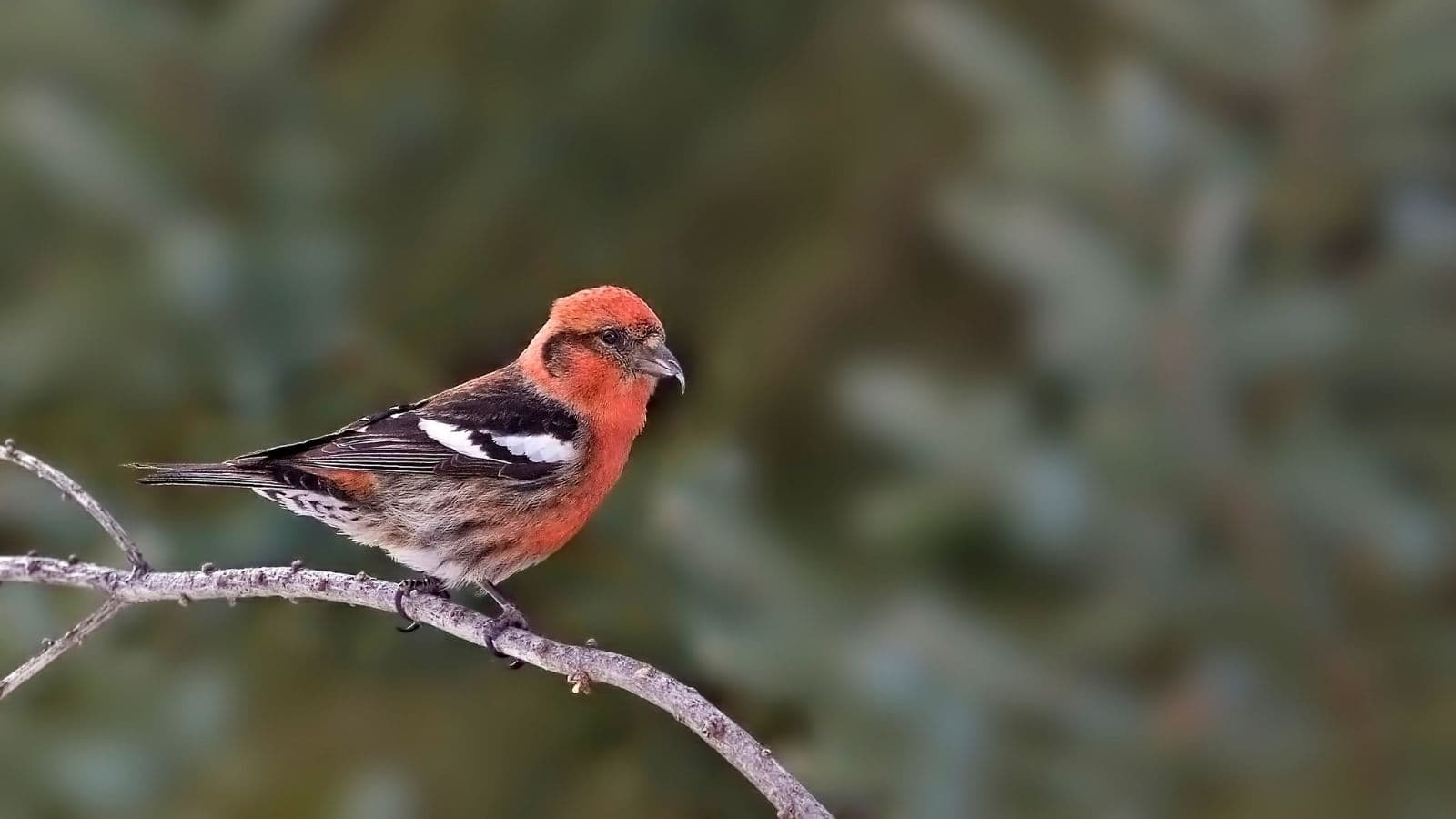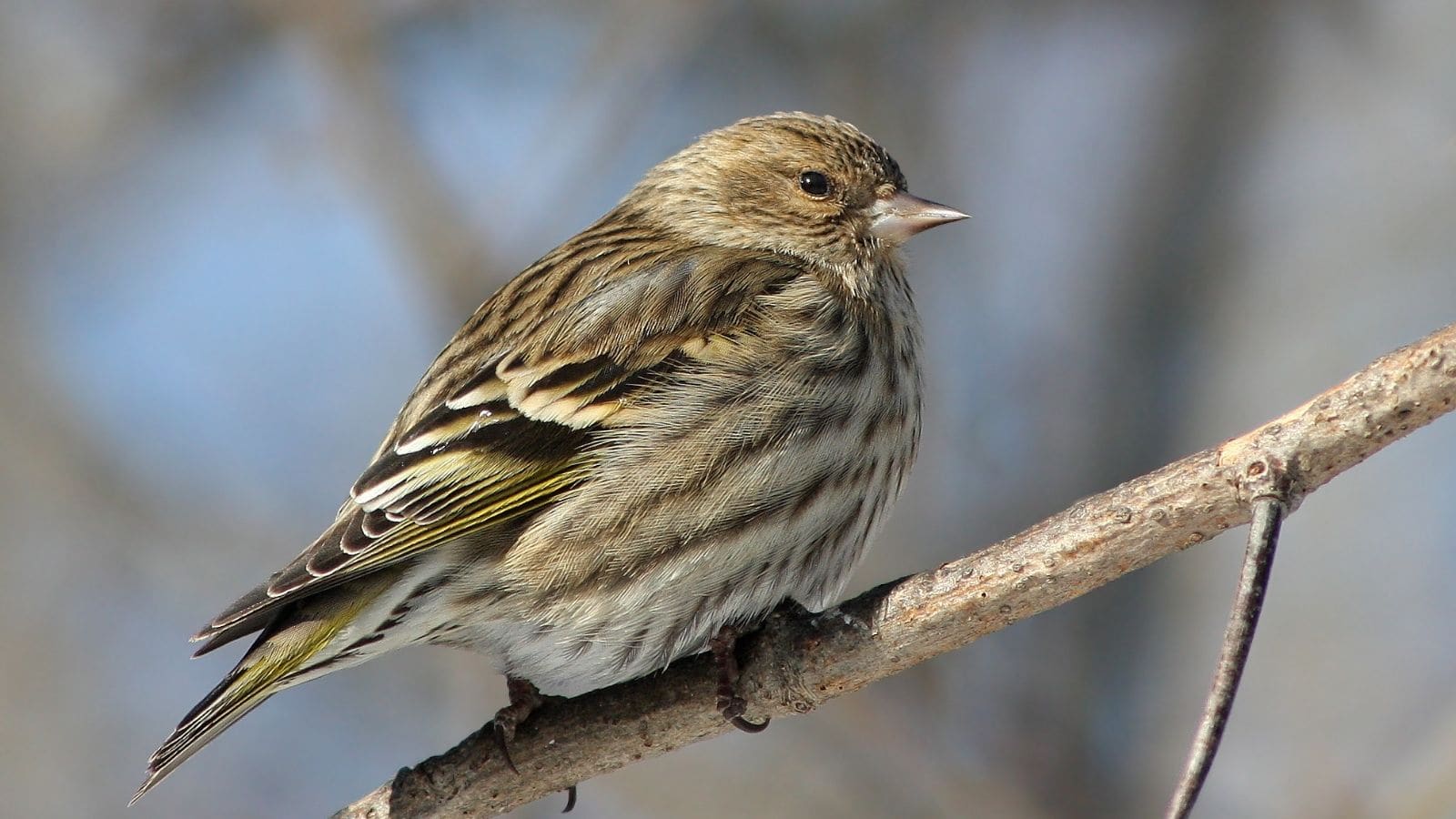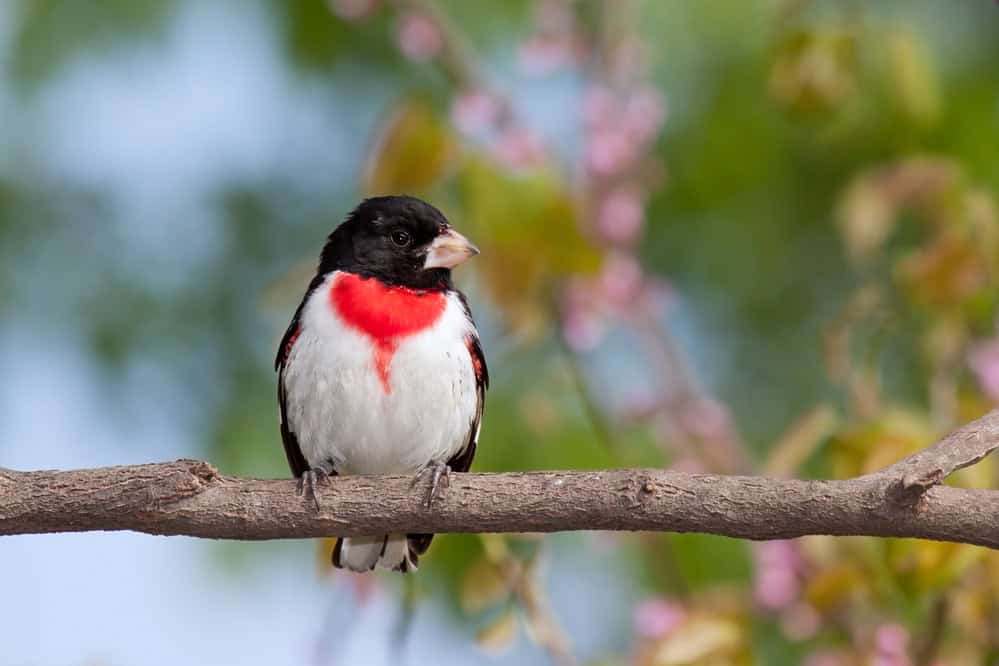Nestled next to the ocean with a hearty helping of forests, North Carolina has a diverse environment for bird watching. There are 10 finches who make their home here and I’ll help you spot them all.
Finches are a fascinating little group of songbirds thanks to their conical bill and diverse diet. These birds easily fit into different climates and aren’t afraid to adapt to human populations.
Whether you live in North Carolina or plan on visiting, a few tips will ensure you don’t miss these fascinating birds. I’ll help you spot 10 common and not-so-common finch species in the state with tips on their feeding habits, birdsong, and more.
White-Winged Crossbill

- Species Name: Loxia leucoptera
- Length: 15 cm to 17 cm
- Weight: 24 grams to 26 grams
- Wingspan: 26 cm to 28 cm
While North Carolina winters aren’t quite as long as other states, you’ll have enough time to glimpse the white-winged crossbill. These finches are a little rare and usually only show up when it gets cold.
Appearance
The male white-winged crossbill is quite handsome with his bold red plumage, dark wings, and large white wing bars. If you look closely, you’ll see where this finch earned his name – he has a unique crossed beak.
The female white-winged crossbill has a lighter and grayer body, but she still boasts color of her own. Expect to see a little yellow or yellow-orange on her neck and rump.
Range
These finches favor spruce forests, so you’ll glimpse them in the state’s more heavily forested northwestern regions. These environments give them plenty of room to feed, breed, and hide from predators.
This is the kind of finch you keep an eye out for if you’re a fan of hiking along scenic mountain trails. The Appalachian Trail is a particularly popular option that may give you a glimpse of this lovely bird.
Diet
This finch usually feeds on tamarack or spruce seeds, though they’ll sometimes feed on various insects once their food supply runs low.
If you’re lucky, you may be able to attract these birds to your feeder with fresh sunflower seeds.
Birdsong
The white-winged crossbill has a lively and repetitive bird song. You’ll hear rapid-fire che-che-chee and chr-chr-chrs that seemingly go on forever.
Fun Fact
Why does their beak look like that, anyway? Turns out it’s an evolutionary adaptation so they can more efficiently dig into pine cones for seeds.
Brambling

- Species Name: Fringilla montifringilla
- Length: 16 cm
- Weight: 23 grams to 29 grams
- Wingspan: 25 cm to 26 cm
This stunning finch is a rare sight in North Carolina, but you’ll want to keep an eye out for it. Their plumage is among the most lavish in the finch family and shouldn’t be missed!
Appearance
The male brambling boasts a tapestry of color – he has a spotted gray and white head with a vivid orange body. Combined with his yellow bill and white belly, he almost looks like a leaf in the fall.
During the breeding season, the male brambling’s head will become a solid black.
The female brambling is darling, boasting a toasty tan-yellow body with a white belly and streaked wings.
Range
These finches are comfortable in a wide variety of environments. They’d just as soon visit a state park as they would birch forests and open fields.
Bramblings are an accidental finch in North Carolina, but have been spotted at bird feeders in the western portion of the state!
Diet
These birds have an appetite for many different foods – they’ll eat nuts, berries, seeds, and insects. However, they prefer to munch on insects during summer, then seeds once it gets cold.
You may be one of the lucky ones to see a brambling at your feeder if you stay stocked on sunflower seeds.
Birdsong
These finches have a more subtle song of buzzy cheeps and light, sparse chirps.
Fun Fact
Beech mast – the edible part of the beech plant – is a favorite food of Bramblings. They love it so much that their local numbers will noticeably change depending on how much beech mast is available.
House Finch

- Species Name: Haemorhous mexicanus
- Length: 13 cm to 14 cm
- Weight: 16 grams to 27 grams
- Wingspan: 20 cm to 25 cm
While you’ll have to maintain a keen eye for the white-winged crossbill and some hope for the brambling, house finches are easy to spot. These common birds appear all throughout the United States.
Appearance
The male house finch has a striking, rosy-red head with a light brown body and red chest. He boasts pale legs and a pale conical bill.
The female house finch has a light brown body with dark wing bars and a streaked stomach.
Range
Whether you love to camp or prefer to bird-watch at home, you’ll spot a few house finches! These birds are year-round residents in North Carolina and show up just about everywhere.
You’ll see flocks of house finches in people’s backyards, farms, and even heavily populated towns.
Diet
House finches have a classic diet of flower buds, seeds, and fruit. As such, they sometimes annoy farmers by constantly digging into their fruit trees.
However, their diverse diet means they’re still not considered a pest species.
If you’re thinking of attracting overhouse finches, stay stocked up on millet and black oil sunflower seeds.
Birdsong
House finches have a seriously lovely song. Expect to hear a sweet, lilting warble that tends to lift up at the end like a question.
Fun Fact
House finches and purple finches are often confused due to their similar coloration. Here’s a tip — male purple finches have more red all over, while house finches usually have it on their head.
Pine Siskin

- Species Name: Spinus pinus
- Length: 11 cm to 14 cm
- Weight: 12 grams to 18 grams
- Wingspan: 18 cm to 22 cm
The charming pine siskin is another easy finch to find due to North Carolina’s abundant forests. However, they can still be a little unpredictable!
Appearance
The male pine siskin is a slender bird with a light yellow-brown body covered in streaks. Their thin bill and pale legs almost make them look like a sparrow.
The female pine siskin…looks quite similar, actually! She tends to have less yellow on her wings, which can be hard to tell at a glance.
Range
Pine siskins have an interesting range for a finch. They sometimes will move beyond their usual range if their food supply gets low, making them somewhat unpredictable.
However, you’re most likely to see pine siskins in North Carolina during fall or spring.
Diet
While pine siskins much prefer to live up to their namesake and eat seeds, they also eat other foods. You’ll sometimes find them nibbling on flower buds or digging through grassweeds.
You can attract pine siskins to your backyard with nyjer seeds or millet.
Birdsong
Even if you can’t spot this bird, you’ll definitely hear them. The pine siskin’s intense tzweee (mixed with buzzy chirps) is hard to miss.
Fun Fact
Have you ever accidentally stepped on a leaf or twig that startled a bird away? Fortunately, the pine siskin is less shy than other finches (and will rarely pass up an opportunity to visit a bird feeder).
American Goldfinch

- Species Name: Spinus tristis
- Length: 11 cm to 13 cm
- Weight: 11 grams to 20 grams
- Wingspan: 19 cm to 22 cm
The American goldfinch is a showstopper of a bird. With their charming call and unforgettable plumage, they’re a popular pick for bird watchers of all stripes.
Appearance
The male American goldfinch has a beautiful lemon-yellow body with black wings and white wing bars. He also has a bright orange bill and a cute little black cap on his forehead.
However, keep in mind his coloration changes to a yellow olive outside of breeding season!
The female American goldfinch looks quite similar to the male with his non-breeding plumage. You can tell the difference by her lack of a black cap.
Range
These finches show up in North Carolina all year long but may be a little less scarce during the winter. They’re comfortable in forested areas as well as weedy fields.
They’re also keen on visiting gardens or backyards if it means a free meal!
Diet
Weed seeds and grasses are their foods of choice. That said, these finches are rather adaptable and will sometimes eat bark, maple saps, and flower buds.
Make your backyard irresistible with nyjer and sunflower seeds. The best feeders for their size and weight are feeder tubes or feeder socks.
Birdsong
Is it any wonder why American goldfinches are so popular? Their birdsong is a melody of sweet cheepa-cheepa-cheeps and airy twittering.
Fun Fact
The American goldfinch only gets more and more charming. These acrobatic birds have a unique flight pattern that makes them appear like they’re bouncing.
Purple Finch

- Species Name: Haemorhous purpureus
- Length: 12 cm to 16 cm
- Weight: 18 grams to 32 grams
- Wingspan: 22 cm to 26 cm
This quaint finch is a rather common sight in North Carolina and a popular pick for backyard birders. Their chatty flocks and comfort around humans make them a real treat to watch.
Appearance
The male purple finch has a berry pink-red coloration extending along most of his body. Their wings are reddish-brown with a little white on their rump.
The female purple finch is sparrow-like with her light brown body and streaked wings. Unlike sparrows, she has a white streak over her eye.
Range
Purple finches show up throughout most of the state during non-breeding season. They’re not super comfortable in densely populated areas but may visit quiet neighborhoods or parks.
These birds generally stick to coniferous forests, particularly where they stretch into lowland areas.
Diet
Purple finches enjoy a plethora of food – they’ll eat everything from berries to seeds to insects. You’ll be able to attract them to your feeder with black oil sunflower seeds or thistle.
Birdsong
These colorful finches have a wonderful, gurgling warble that ends on a high note (literally!). They often have long pauses in between.
Fun Fact
Purple finches are an irruptive species, which means they’ll switch up their migration pattern if their food supply runs low.
Red Crossbill

- Species Name: Loxia curvirostra
- Length: 14 cm to 17 cm
- Weight: 40 grams
- Wingspan: 25 to 27 cm
These stocky birds almost look parrot-like in their appearance. Their rounder bodies and larger bills are atypical of most species in the finch family.
Appearance
The male red crossbill has a lovely red or orange-red body with dark wings and thin white wing bars. Their white patches aren’t nearly as large as the similar white-winged crossbill.
However, these birds all share the same curious beak shape – a bill that criss-crosses when closed.
The female red crossbill has smoothly colored wings and leans toward shades of yellow and yellow-orange.
Range
These birds tend to show up in the western portion of the state during breeding season. However, there are small pockets of forest where they’ll stick around much longer.
Diet
The red crossbill spends much of its time digging around in coniferous forests for seeds to eat. However, they have a tendency to branch out and try new things if their food supply runs low.
You’ll sometimes find these birds trying out berries and insects. Try attracting them with sunflower seeds or a little suet when it gets cold – you’ll make their day!
Birdsong
The red crossbill song is lilting and sweet, often composed of repetitive chirping and whistles.
Fun Fact
Red crossbills are such big fans of salt, they’ll try to get it just about anywhere. They’ve even been observed eating from coal ashes or pork barrels!
Evening Grosbeak

- Species Name: Hesperiphona vespertina
- Length: 16 cm to 22 cm
- Weight: 38 grams to 68 grams
- Wingspan: 30 cm to 36 cm
Another dashing finch to spot during the winter season is the evening grosbeak. This bird is often a surprise for bird watchers thanks to its large size and unusually bright coloring.
Appearance
Adult males have a gorgeous blend of colors. They boast golden yellow for the body, black for the wings, and big white wing patches.
Their thick yellow eyebrows have a way of making them look like they’re scowling.
The female evening grosbeak looks similar to the male but with a more gray-olive body. You may glimpse a little yellow along their neck.
Range
Evening grosbeaks are a little rarer in North Carolina but have a tendency to show up during winter for extra food. While they spend much of their time exploring mountains and forests, they’re adaptable birds that will always try something new.
As such, they’re likely to show up to your bird feeder if you keep it stocked.
Diet
The evening grosbeak’s diet will change depending on the seasons. They dine on insects during the summer but switch to fatty seeds when it’s cold.
Invite these gorgeous finches over with a hearty helping of sunflower seeds. Make sure to use a platform feeder to support their larger weight.
Birdsong
This finch’s buzzy trill is immediately recognizable. They have a rapid, in-and-out pattern that sounds like panting.
Fun Fact
The evening grosbeak’s bill will become a more intense color during the breeding season.
Blue Grosbeak

- Species Name: Passerina caerulea
- Length: 14 cm to 19 cm
- Weight: 26 grams to 31 grams
- Wingspan: 26 cm to 29 cm
Are you a bird watcher who tries to be as quiet as possible when observing birds? You might be able to spot the blue grosbeak, a rather shy finch.
Appearance
The male blue grosbeak is incredibly dashing with his jewel-like coloration. He has a blue body with brown wing bars and a bright gray bill.
The female blue grosbeak is lovely in her own right. She has a light gray body with hints of brown and blue along her back.
Range
The blue grosbeak usually shows up in North Carolina during breeding season. I recommend this finch for backyard bird watchers since they’re nervous around humans and prefer quieter environments.
Diet
Unlike most finches, the blue grosbeak prefers to eat insects. Caterpillars, beetles, grasshoppers, you name it!
However, they’ll still try a few seeds, particularly when the colder months hit.
You may be able to attract them to your backyard feeder with sunflower seeds. However, be sure to place your feeder somewhere shrubby and overgrown to help them feel safe.
Birdsong
These finches have an interesting warble that sometimes ends in buzzy trills.
Fun Fact
Look familiar? The blue grosbeak is easy to confuse for popular bird-watching staples like the blue jay or the western bluebird.
Rose-Breasted Grosbeak

- Species Name: Pheucticus ludovicianus
- Length: 18 cm to 22 cm
- Weight: 35 grams to 65 grams
- Wingspan: 29 cm to 33 cm
If you’ll be in North Carolina during the warmer months, keep a sharp eye out for rose-breasted grosbeaks.
Appearance
The male rose-breasted grosbeak shows off his namesake with a striking red throat and chest. His black body and white belly make him one of the most iconic finches in the finch family.
The female rose-breasted grosbeak looks so different that she’s sometimes confused for other finch species. She has a light brown and white body covered in long streaks.
Range
Rose-breasted grosbeaks usually pass through the majority of the state during migration. However, a small portion crops up in the west during breeding season.
Deciduous forests are their go-to habitat, though they sometimes show up around forest edges and state parks. As such, consider looking for this finch if you’re going on a family trip or a leisurely nature walk.
Diet
These finches are a dynamic bunch, switching up their source of food depending on the season. They usually feast on insects and berries, but will sometimes try a little nectar during spring.
See if you can attract this stocky finch to your backyard bird feeder with a few sunflower seeds. It’s important to note they usually prefer platform feeders.
Birdsong
These birds have such a powerful whistle, you may just confuse it for a human’s! Expect to hear loose warbles and light whistles with long pauses in between.
Fun Fact
If you’re familiar with other songbirds, you may notice the rose-breasted grosbeak sounds quite similar to an American robin.
North Carolina Has a Hearty Helping of Finches for Passionate Birders
North Carolina is absolutely brimming with opportunities to see nature’s best up close. Even better, many of these finches are adaptable enough to show up in a variety of environments.
If you prefer backyard birding, you might see American goldfinches or even a blue grosbeak. If you prefer to go backpacking through the rugged wilderness, you may see white-winged crossbills!
These aren’t the only species you can glimpse. Our guide on birds in North Carolina has a broader overview of the state’s gorgeous bird population.

